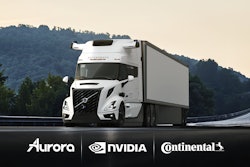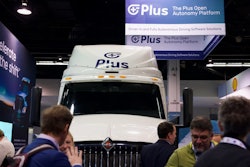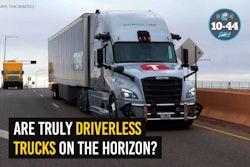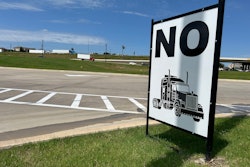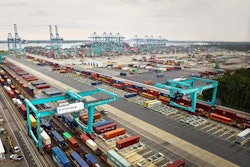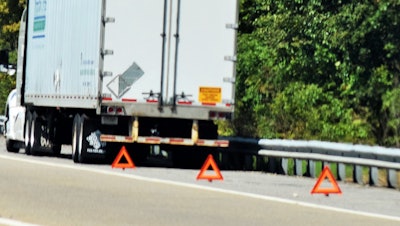
The Federal Motor Carrier Safety Administration is under fire from autonomous truck technology developer Aurora following the agency’s decision late last year to deny a petition from Aurora and Waymo requesting an exemption from a regulation about the placement of warning devices.
Aurora on Jan. 10 filed a lawsuit in the U.S. District Court of Appeals for the District of Columbia Circuit against the U.S. Department of Transportation and the FMCSA, petitioning the court to review the application denial, claiming FMCSA’s decision “stifles safety innovation and would impede the development of the autonomous trucking industry for no valid or lawful reason.”
In their request, Aurora and Waymo were seeking permission to use “cab-mounted warning beacons” as roadside warning devices when their trucks, and those of “other similarly situated companies,” are operating either without a human on board or with a human on board when testing the warning beacons.
Existing regulations require “whenever a commercial motor vehicle is stopped upon the traveled portion of the shoulder of a highway for any cause other than necessary traffic stops, the driver shall" put down warning devices on the traffic side facing approaching traffic, another one 100 feet back in the lane or shoulder, and another one 100 feet away facing away from oncoming traffic.
[Related: FMCSA denies exemption request for autonomous trucks]
In denying the petition from Aurora and Waymo, FMCSA said the “broad exemption is not supported by the data presented and lacks necessary monitoring controls to ensure highway safety.” The agency added, however, that the denial “does not preclude applicants or others from seeking an exemption to use better-defined warning beacons for specified companies in particular locations, as one of the bases of the agency’s decision here is the broad reach of applicants’ request.”
In a Jan. 10 blog post, Aurora President Ossa Fisher said the company believed that while the FMCSA’s decision to deny the application “does not prevent us from complying with existing regulations when we launch our driverless trucks in April, this decision raises a more important question: as Americans, how do we think about safety and innovation on our roads?”
Fisher argued that “safe, accessible roadside warning systems have already been implemented outside of trucking,” specifically with emergency and construction vehicles using high-visibility flashing lights, she noted. Fisher also said the current “roadside warning system is outdated,” noting that the hand placement of warning triangles “is not only over half a century old,” but “it has never been updated and is not backed by any data or research showing that it improves safety.”
[Related: Aurora partnerships to allow autonomous truck deployment at scale]
Fisher also contended that “urgent action is needed to reduce roadside fatalities,” noting that under the current warning triangle system, “countless truck drivers have been killed by oncoming vehicles while placing these warning triangles.”
Less than two weeks after denying Aurora and Waymo’s petition, FMCSA in a Federal Register notice published Jan. 8 signaled its intent to launch a “Study of Warning Devices for Stopped Commercial Motor Vehicles,” which the agency called “an experimental study that requires data collection for evaluating whether warning devices meaningfully influence crash-relevant aspects of human performance in the presence of a parked or disabled commercial motor vehicle, and if so, how and to what extent.”
The notice announced the agency’s plan to submit an Information Collection Request (ICR) to the White House’s Office of Management and Budget to move forward with the information collection.
FMCSA noted that “advances in automated driving system (ADS) technology have raised critical questions regarding potential barriers to regulatory compliance with warning device safety standards and regulations, which reference or require a ‘driver.’” FMCSA also said that “alternative types of warning devices developed by the industry, including those intended to increase driver safety during device deployment, have resulted in multiple applications for exemption from the corresponding safety regulations.”
[Related: Former FMCSA deputy administrator joins autonomous tech firm]
The agency added, “These recent issues related to warning device requirements also call attention to the historically unresolved questions of whether the use of such devices improves traffic safety and, if so, how and to what extent.”
Aurora’s Fisher acknowledged FMCSA’s move, noting that more than 50 years since warning triangles were mandated, “FMCSA just this week announced that they are going to look into the crash prevention benefits of those devices for the first time.”
FMCSA said that past attempts by Federal Highway administrators and other researchers to answer questions related to warning triangles’ effectiveness and impact on safety “yielded generally inconclusive or inconsistent results,” possibly influencing a past decision by the National Highway Traffic Safety Administration to not pursue conducting its own research on the topic.
“As the only regulatory authority which still requires CMV operators to use warning devices, the responsibility to answer these questions finally and definitively is best charged to FMCSA,” the agency said.
In its lawsuit challenging FMCSA’s decision to deny its petition for a waiver from the warning device regulation, Aurora said the agency “arbitrarily and capriciously denied the application contrary to record evidence and without adequate, reasoned explanation.” Aurora argued that cab-mounted warning beacons (CMWBs) “would achieve a level of safety at least equivalent to the level of safety absent the exemption.”
[Related: Major fleet completes 50K autonomous miles]
The company said its request “was supported by two separate studies, conducted by the Virginia Tech Transportation Institute and Aurora, reflecting the responses of several thousand road users” across a variety of road conditions. “Both studies demonstrated that CMWBs are equally or more effective in enabling road users to detect, recognize and react to the hazard presented by a CMV parked on a roadway as compared to human-placed warning devices, causing such road users to slow down and/or change lanes in response.”
Aurora alleged that when assessing whether CMWBs are at least “equivalent” to driver-placed warnings when it comes to safety, the data they provided to FMCSA “far exceeds what FMCSA has admitted about the agency’s existing requirements: FMCSA has ‘never conducted experimental research on the impact of using’ the currently-mandated human-placed warning devices, and it is ‘historically unresolved’ whether ‘the use of such [driver-placed] devices improves traffic safety and, if so, how and to what extent.’”
FMCSA’s denial, Aurora concluded in its lawsuit, “is at odds with the law and with FMCSA’s own public commitment to support safety innovation, and it inhibits the further development of vital self-driving technologies in a manner contrary to the standards of section 706 of the Administrative Procedure Act. In the absence of correction by the agency itself, this denial requires review and correction by this Court.”
[Related: How autonomous trucks will impact the trucking workforce]


